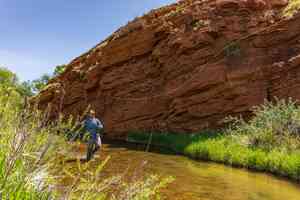Anybody who powered through a high-school psychology class probably remembers Maslow’s famous triangle chart—the famous Hierarchy of Needs.
At the base of the triangle lie our foundational needs—things like food, shelter, sleep, sex. Higher up, and slightly less important, are still-important needs, like safety, financial security, emotional well-being, etc. Still higher up, and still less important than the foundational needs, are things like love and acceptance, self esteem and, finally, self-actualization.
While this may not seem to have much to do with trout fishing, it really does. For the trout. Not so much for us anglers. Don’t get too excited. It’s doubtful that trout crave self-actualization.
The trout’s Hierarchy of Needs might start and end with the basest of requirements: food, safety and security, shelter and sex.
Anybody who’s spent more than a few days chasing trout knows they like structure—places to hide, both for the purpose of avoiding predators, and for the purpose of ambushing prey and finding food.
Undercut banks. Big rocks. Big wood. Overhanging branches. All help a trout meet its basic needs.
But often, anglers overlook a great place to find trout the needs at the base of the triangle: the foam line.
Consider the foam line the equivalent of the pizza delivery driver. It brings food directly to the shelter. A line of floating foam may not seem substantive, but consider that many predators that go after trout come at them from above—eagles, ospreys, etc. Foam lines break up the water’s surface just enough to make trout feeding on or near the water’s service more difficult to see, even for sharp-eyed raptors. That gives trout more security.
And foam lines generally occur below other features in a river or a stream, like a rapid or a waterfall. This means the water is likely well oxygenated and prime for holding fish that are on the prowl.
While it may not seem like real substantial structure, foam lines give trout a reasonable amount of security—enough confidence to venture out from under the bank or the root wad to go after food that’s drifting downstream. It may only be the illusion of safety, but it works for the fish, and it’s water we should never just wander by without at least making a cast and a drift, particularly if the water beneath the foam has any reasonable depth to it.
Here in Idaho, I fish rivers like the Henry’s Fork and the South Fork, both well-oxygenated tailwaters that have lots of foamy runs. One of my favorite South Fork side channels that I like to walk and wade in the fall has a deep eddy that features a giant foam mat. Trout will nose up through an inch of foam to get after Blue-winged Olives that get caught in the muck. Needless to say, the fishing can be stellar.
But foam lines aren’t just great for dry-fly fishing. Dropping a nymph under high-floating dry fly can be absolutely deadly, as can high-sticking a double-nymph rig through foamy water. Even streamers pulled under foam lines can work.
On smaller water, like my backcountry cutthroat creeks here along the Idaho-Wyoming border, foam lines offer great opportunities, starting in the late spring when native cutthroats are running upstream to spawn out of rivers like the Snake, the Greys and the Salt. Higher, slightly stained water from runoff helps trout feel more secure, but they’ll still gravitate to foam lines in search of food delivery.
Rocks are still great places to chase trout. Undercut banks will almost always hold fish. Wood? Wood is good.
But foam? Foam is home.































Comments
Clint replied on Permalink
Years ago after a fishing trip, a friend from the trip gave me a shirt that had FFF
in larger print. Those F's were the beginning of three words that highlighted the entire
5 day float trip.
Foam Fishing Fools.
Pages